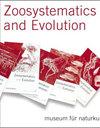对印度 Phintella Strand, 1906 属(鹤形目,鮨科,蝶形目)知识的补充
IF 1.6
2区 生物学
Q2 ZOOLOGY
引用次数: 0
摘要
新种(♂♀)、P. handersonisp.nov.(♂♀)、P. lunasp.nov.(♀)和P. rajbharathisp.nov.(♂)。此外,描述了Phintella platnicki Sudhin, Sen & Caleb, 2023的未知雌性,并为该种提供了新的分布数据。accentifera (Simon, 1901) 的模式产地和分布情况,并澄清了其他非模式材料的身份。此外还提供了详细的形态描述、插图和分布图。本文章由计算机程序翻译,如有差异,请以英文原文为准。
Additions to the knowledge on the genus Phintella Strand, 1906 (Araneae, Salticidae, Chrysillini) from India
Four new species of the chrysilline genus Phintella – P. dentissp. nov. (♂♀), P. handersonisp. nov. (♂♀), P. lunasp. nov. (♀) and P. rajbharathisp. nov. (♂) – are described from India. Additionally, the unknown female of Phintella platnicki Sudhin, Sen & Caleb, 2023 is described and new distributional data are provided for this species. Notes on the type locality and distribution of P. accentifera (Simon, 1901) are provided along with clarification on the identity of other non-type materials. Detailed morphological descriptions, illustrations and a distributional map are also given.
求助全文
通过发布文献求助,成功后即可免费获取论文全文。
去求助
来源期刊

Zoosystematics and Evolution
ZOOLOGY-
CiteScore
3.50
自引率
5.00%
发文量
34
审稿时长
16 weeks
期刊介绍:
Zoosystematics and Evolution, formerly Mitteilungen aus dem Museum für Naturkunde in Berlin, is an international, open access, peer-reviewed life science journal devoted to whole-organism biology. It publishes original research and review articles in the field of Metazoan taxonomy, biosystematics, evolution, morphology, development and biogeography at all taxonomic levels. The journal''s scope encompasses primary information from collection-related research, taxonomic descriptions and discoveries, revisions, annotated type catalogues, aspects of the history of science, and contributions on new methods and principles of systematics. Articles whose main topic is ecology, functional anatomy, physiology, or ethology are only acceptable when of systematic or evolutionary relevance and perspective.
 求助内容:
求助内容: 应助结果提醒方式:
应助结果提醒方式:


